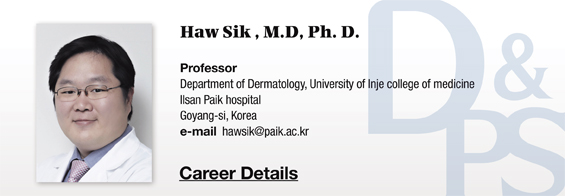Vitiligo is not a disease accompanying problematic symptoms such as pain, but its appearance on the exposed skin areas may result in undesirable aesthetic issues. A lot of patients with vitiligo often experience psychological stress as well as interferences with social life because of nevus depigmentosus. Vitiligo treatment, therefore, may have a direct impact on patients, such as by enhancing their quality of life. In this series, Dr. Haw Sik (Prof. of Dermatology, Inje University Ilsan Paik Hospital) will introduce various aspects of vitiligo, including the cause, clinical features and treatment modalities. We hope this series would be of much help to our readers.
[Advertisement] COPPER BROMID(Yellow/Green Laser) – Manufacturer: BISON MEDICAL(www.bisonmedical.com)
There are many treatment options available for vitiligo. To put it another way, vitiligo is not treatable with one method and requires a combination of multiple treatments, which are roughly divided into pharmacotherapy, phototherapy and surgical therapy.
1. Pharmacotherapy
Steroids
Steroids are most widely used as first-line therapy. They always raise a conflict between the therapeutic effects and side effects, but remain the most effective medicine among single agents, and also as a combination with phototherapy. A lesion of progressive vitiligo houses inflammatory cells consisting of macrophages and T cells and shows melanocyte destruction by autoantibodies and complements. Steroids prevent the melanocyte destruction by this mechanism and stimulate melanocyte redistribution and melanin synthesis in vitiligo lesion.
As clarified in a number of studies, topical steroids are more effective in children than in adults, and exert the maximum effect when applied to lesions in the head and neck region. They are also compatible with ultraviolet A. According to a study by Westerhof, topical fluticasone combined with UVA therapy, provides approximately 3 times superior therapeutic effect compared to fluticasone monotherapy.
Oral steroids are not considered as a first-line therapy nowadays due to the possibility of side effects. In terms of disease control by inhibition of immune response, however, they are one of the excellent treatment options.
The therapeutic effect of oral steroids can be enhanced by combining with ultraviolet phototherapy. Rath et al. compared the efficacy of oral mini-pulse of steroid (OMP) alone, OMP with PUVA and broad/narrow band UVB phototherapy in patients with progressive vitiligo. Among them, OMP with narrow band UVB therapy showed the most superior efficacy.
The biggest issue in use of steroids is topical and systemic side effects; the former including epidermal atrophy, vasodilatation, stria distensae and folliculitis, and the latter including insomnia, acne, menstrual irregularity, weight gain, pilosis and adrenal insufficiency. Topical steroids alone can affect the serum cortisol level, which is far more associated with the location of application, that is, head and neck, rather than the strength of steroid. Approximately 69% of patients using pulse steroid therapy experienced systemic side effects in a study. Therefore, it is imperative to consider the risk of side effects before and during steroid therapy.
Topical Calcineurin Inhibitors
Topical calcineurin inhibitors are good options when attempting to inhibit immune response without the risk of side effects. It also has an almost equal efficacy to topical steroids. Calcineurin acts as a transcription factor of inflammatory cytokines, such as IL-2 and TNF-α, in lymphocytes and dendritic cells. Compared to normal population, patients with vitiligo are well known to have increased levels of IL-10, TNF-α and IFN-γ. Topical calcineurin inhibitors reduce TNF-α and stimulate the proliferation of melanocytes and melanoblasts in tissue .
A number of studies have reported that 63-89% of patients showed symptom improvement after 3-6 months of using topical tacrolimus and pimecrolimus, and that lesions in the head and neck benefited the most. Because they induce only mild side effects, refractory lesions in the limbs may be improved by wrapping the lesion after applying the ointment.
Topical calcineurin inhibitors, when used alone, have an efficacy similar to or slightly lower than topical steroids, but the efficacy can be improved by combining with a narrow band UVB phototherapy or 303 nm excimer laser. Combination with phototherapy is also effective for the treatment of vitiligo not responding to other treatment modalities.
Common side effects include erythema, pruritus, irritation, hyperpigmentation and acne, but they tend to be mild. Topical calcineurin inhibitors were once suspected to increase the risk of developing skin cancer in immunosuppressed patients, but the association was not confirmed, and no correlation with lymphoma and other types of skin cancer was found in an additional study involving more than 20,000 patients.
Vitamin D3 Derivatives
Calcipotriene, among Vitamin D3 derivatives, is also used for the treatment of vitiligo. Calcipotriene has a immunoregulatory function and improves melanocyte development and melanin synthesis. As it shows lower efficacy than steroids when used alone, it is often used as an adjuvant to topical steroids.
Calcipotriene combined with topical steroids enhances efficacy, speeding the repigmentation of lesion, and may also be effective for lesions not responding to topical steroids alone. The efficacy of combination with phototherapy is still controversial and requires further studies. Side effects are not significant and may entail a slight irritation.
Antioxidants
Although not highly stressed in Korea, antioxidants are used for preventing the destruction of melanocytes by reactive oxygen species. Antioxidants, such as Vitamin E and C, alphalipoic acid, ginkgo biloba, topical catalase, superoxide dismutase and polypodium leucotomos, are commonly used for treatment of vitiligo.
Methionine sulfoxide reductase, which protects cell from reactive oxygen, is reduced in vitiligo lesion, leading to melanocyte damage by oxidative stress. Intake of alphalipoic acid, vitamin C, vitamin E or polyunsaturated fatty acids is considered to activate catalase and reduce the activation of reactive oxygen species.
There are not many studies supporting the therapeutic effect of antioxidants on vitiligo. DellAnna et al. reported narrow band UVB phototherapy combined with an antioxidant was superior to phototherapy alone. Another study demonstrated that topical application of catalase/superoxide dismutase was as effective as 0.05% topical betamethasone. Antioxidants are relatively safe and inexpensive, but the absence of a specifications of possible side effects, dosage and efficacy calls for further studies.
-To be continued-
▶ Previous Artlcle : #1-2. Vitiligo Treatment





















